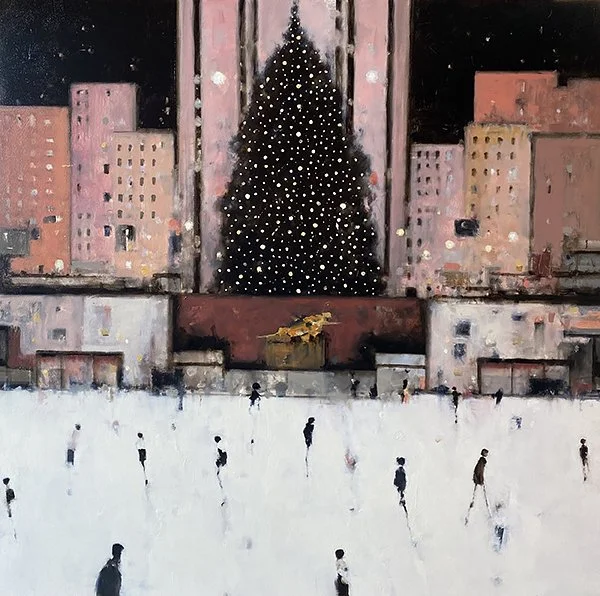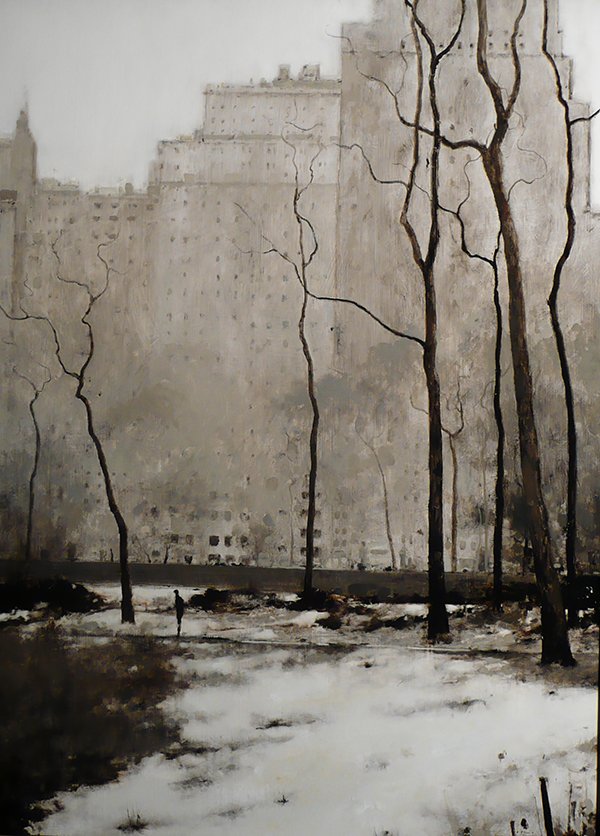Talent Crush: Geoffrey Johnson
Fran Lebowitz once said that it would take one subway ride for the Dalai Lama to turn into a lunatic. Anyone who’s ever lived in New York City would second that notion in a heartbeat as having contact with human beings is something you try to avoid at all costs. In fact, no depiction of the city can be realistic enough without capturing the feeling of chronic loneliness and social isolation. Accentuated by a monochromatic palette, Geoffrey Johnson’s impressionistic paintings are neither about the people, nor about the architecture, yet they deliver the most accurate portrait of the city, extending far beyond reproducing its urban landscape. We talked about Geoffrey’s process, artistic influences, and his everlasting relationship with the city.
KELLY KORZUN: You were born in Greensboro, North Carolina, and ended up studying at the Pennsylvania Academy of the Fine Arts in Philadelphia, the oldest art school in the United States. As someone who lived in both North Carolina and Philly, I can assume how transformative this transition might have been back in the day, especially in the late 80s. What was your expectation and strategy of making it in the art world when you first came to Philadelphia?
GEOFFREY JOHNSON: At the time, the idea I could pursue art as a career was beyond reach to me. I thought an artist couldn’t make a living without going into commercial art, so I’d never really known I could have a strategy or expectations. I was completely out of sorts and really concerned about going back to school at 25 and being the old guy amongst recent high school graduates, but I ended up being one of the youngest students at the Academy simply because of its reputation. Being surrounded by so much talent was something I’d never experienced before, so my strategy was just trying to take all that in and learn.
February, 40x30 inches, oil on panel
KK: You’ve studied under Sidney Goodman, one of the most recognized figurative artists in the country, who was also responsible for your blistering transition from watercolors to oils. What kind of relationship did you have with him after your graduation, and what principles or insights of that mentorship have you extrapolated to your own creative process?
GJ: Unfortunately, Sidney and I mostly lost touch after graduation when I moved to Atlanta. However, I did speak with him on several occasions. He was encouraging and wanted to make sure I stayed on the course I was on: get gallery exposure. Sidney was very instrumental in a lot of ways. He did the proverbial push out of the nest and forced me out of my comfort zone with the little painting knowledge I had. At the time, I was painting photorealistically. He pushed me to experiment, which was the best advice I ever had. My mindset had always been that I was supposed to finish a work of art to validate that accomplishment. Sidney erased that misconception. He really pushed my creativity and encouraged me not to be overtaken by the idea that every piece had to be perfect.
KK: I think one of the very distinctive things about New York, as well as something you end up simultaneously loving and hating about the city, is this feeling of being absolutely invisible, anonymous, and disconnected, which you happen to portray very well in your paintings. What was your impression of New York when you first came here in the 90s, and how do you think that feeling transformed over the years?
GJ: My uncle lived on the Upper West Side, so I spent a lot of time in New York in the 1970s as a child. The stimulation of the city and its urban life grabbed me right away, which was foreign to me. My uncle would send me off into the city alone at 14 or 15. It opened up a whole new world for me. Later, when I was taking train to NYC on weekends and holidays during my years at the Academy, the city took on another role of my desire to paint it as I started seeing it in a different light. New York can give the feeling of anonymity, which can be good or bad. My uncle could be very loud with storytelling on the subway and no one would even look up. That’s why celebrities live there; you can be invisible and people mind their own business. As far as the transformation goes, there’s a big difference between being a single artist and a married guy with two sons. All of a sudden, you spend more hours climbing granite boulders in Central Park, and visiting Natural History Museum becomes more important than hitting art museums and bars, which only proves that this city is inexhaustible; it’s always different yet familiar at the same time.
City bridge, 36x24 inches, oil on panel
KK: To me, you depict New York as if it’s a living and breathing creature, a full-fledged subject, rather than just an object or a part of the landscape. It also has a very prominent Degas imprint to it – not only because of a similar muted color palette, strong contrasts and a slightly off-center composition, but also because the scenes you paint are infused with this feeling of immediacy, very similar to what I get from looking at his work. Besides being pushed by Goodman and the Academy, what else has informed your signature style as an artist?
GJ: Degas, Matisse…there’s a certain quality of their work I’ve always been drawn to – flat, yet three-dimentional and you can move around in it. There are always images that are registered in the back of your mind that sometimes come to the forefront later. My wife and I were in London. We came out of the V&A Museum along with a crowd. It had rained and the sun came out. Suddenly, all people were in silhouette – high contrast, bright and dark. Months later, that image from London popped in my head and I started painting. That was the beginning of the limited palette pieces. Occasionally, I still paint in color, but I don’t really see the City in it.
57th street, 36x24 inches, oil on panel
KK: There are many great art spaces located in the Upper East Side, especially down 57th street. Besides Hubert Gallery that’s been representing you for many years now, what are your go-to galleries in the city?
GJ: One of my downfalls is I have not made it a practice to go to galleries. There’s always been a notion of isolating myself as an artist to not get distracted or influenced by what everyone else is doing, yet I’m torn because I love looking at art. In the old days, just out of the Academy, I would go to Forum Gallery, Tatistcheff & Co, and galleries in Soho that are gone now. That being said, I visit museums when I can.
Up 5th avenue, 52x50 inches, oil on panel
KK: You once mentioned that you love watching music documentaries and hearing the musicians discussing their craft as there are many parallels between music and art, which is something I can absolutely relate to. Is there a musician whose creative philosophy you find resemblant of yours?
GJ: The documentaries are fascinating to me. My wife is very knowledgeable, a music buff, especially when it comes to The Beatles and other rock bands. It’s not the creative philosophy I identify with, it’s the creative process or lack thereof. What I witness in watching musicians work both terrifies and encourages me. How did I do that? Can I do that again? What if I can’t do that again?








